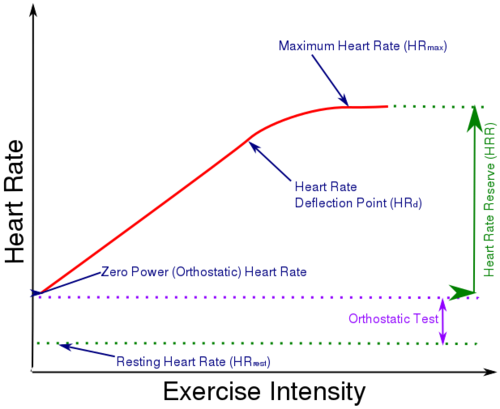Difference between revisions of "Heart Rate"
From Fellrnr.com, Running tips
User:Fellrnr (User talk:Fellrnr | contribs) |
User:Fellrnr (User talk:Fellrnr | contribs) m (comment: batch update) |
||
| (2 intermediate revisions by the same user not shown) | |||
| Line 1: | Line 1: | ||
| − | [[File:HeartRateSimplified. | + | [[File:HeartRateSimplified.svg|right|thumb|500px|A simplified chart of heart rate against exercise intensity showing [[Maximum Heart Rate]], [[Heart Rate Reserve]], [[Resting Heart Rate]], [[Orthostatic Heart Rate]], and [[Heart Rate Deflection]].]] |
As exercise intensity increases the heart beats faster, and it's relatively easy to measure heart rate while exercising. This makes heart rate a simple way of evaluating exercise intensity, but you need to understand a couple of common issues to use it effectively. | As exercise intensity increases the heart beats faster, and it's relatively easy to measure heart rate while exercising. This makes heart rate a simple way of evaluating exercise intensity, but you need to understand a couple of common issues to use it effectively. | ||
* Exercise heart rate should be evaluated as a percentage of [[Heart Rate Reserve]]. However, you need to do an individual test to determine [[Maximum Heart Rate]]. Never use a formula to predict Maximum Heart Rate, as these formulas are useless. If you do a Maximum Heart Rate test, then you can calculate your [[Heart Rate Reserve]], which can be used to estimate exercise intensity. | * Exercise heart rate should be evaluated as a percentage of [[Heart Rate Reserve]]. However, you need to do an individual test to determine [[Maximum Heart Rate]]. Never use a formula to predict Maximum Heart Rate, as these formulas are useless. If you do a Maximum Heart Rate test, then you can calculate your [[Heart Rate Reserve]], which can be used to estimate exercise intensity. | ||
* A second significant problem with Heart Rate Training is that the relationship between Heart Rate and exercise intensity often changes during prolonged exercise, a phenomenon known as [[Heart Rate Drift]]. | * A second significant problem with Heart Rate Training is that the relationship between Heart Rate and exercise intensity often changes during prolonged exercise, a phenomenon known as [[Heart Rate Drift]]. | ||
| − | = | + | =The Heart Rate to Effort Relationship= |
| − | * [[ | + | There are several aspects to the relationship between heart rate and effort (power output.) |
| − | * [[ | + | * [[Resting Heart Rate]] (HR<sub>rest</sub>) is how fast your heart beats when you are not expending any energy beyond simply being alive. There's also "Zero Power Heart Rate" which is when you're standing or sitting on a bike without any other exertion. |
| − | * [[Heart Rate | + | * [[Orthostatic Heart Rate]] (HR<sub>orth</sub>) is the heart rate when standing, and is typically 10-15 BPM higher than HR<sub>rest</sub>. I think of this as "Zero Power Heart Rate." The difference from resting is part of the [[Orthostatic Heart Rate Test]]. |
| − | + | * [[Heart Rate Deflection]]. Heart rate is generally considered to be linear with effort (power output) up to about 80% of Maximum Heart Rate, and this deflection is often used to estimate [[Lactate Threshold]]. | |
| − | * [[Heart Rate | + | * [[Maximum Heart Rate]] (HR<sub>max</sub>) is the fastest rate the heart is capable of beating and it must be tested as it cannot be calculated. |
| − | * [[Heart Rate | + | * [[Heart Rate Reserve]] is the difference between HR<sub>max</sub> and HR<sub>rest</sub>, thought I believe that HR<sub>orth</sub> should be used instead of HR<sub>rest</sub>. It's a better measure of intensity than %HR<sub>max</sub>. |
Latest revision as of 17:08, 6 February 2019

A simplified chart of heart rate against exercise intensity showing Maximum Heart Rate, Heart Rate Reserve, Resting Heart Rate, Orthostatic Heart Rate, and Heart Rate Deflection.
As exercise intensity increases the heart beats faster, and it's relatively easy to measure heart rate while exercising. This makes heart rate a simple way of evaluating exercise intensity, but you need to understand a couple of common issues to use it effectively.
- Exercise heart rate should be evaluated as a percentage of Heart Rate Reserve. However, you need to do an individual test to determine Maximum Heart Rate. Never use a formula to predict Maximum Heart Rate, as these formulas are useless. If you do a Maximum Heart Rate test, then you can calculate your Heart Rate Reserve, which can be used to estimate exercise intensity.
- A second significant problem with Heart Rate Training is that the relationship between Heart Rate and exercise intensity often changes during prolonged exercise, a phenomenon known as Heart Rate Drift.
The Heart Rate to Effort Relationship
There are several aspects to the relationship between heart rate and effort (power output.)
- Resting Heart Rate (HRrest) is how fast your heart beats when you are not expending any energy beyond simply being alive. There's also "Zero Power Heart Rate" which is when you're standing or sitting on a bike without any other exertion.
- Orthostatic Heart Rate (HRorth) is the heart rate when standing, and is typically 10-15 BPM higher than HRrest. I think of this as "Zero Power Heart Rate." The difference from resting is part of the Orthostatic Heart Rate Test.
- Heart Rate Deflection. Heart rate is generally considered to be linear with effort (power output) up to about 80% of Maximum Heart Rate, and this deflection is often used to estimate Lactate Threshold.
- Maximum Heart Rate (HRmax) is the fastest rate the heart is capable of beating and it must be tested as it cannot be calculated.
- Heart Rate Reserve is the difference between HRmax and HRrest, thought I believe that HRorth should be used instead of HRrest. It's a better measure of intensity than %HRmax.